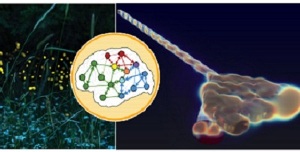Jul 18 2017
A simulation study headed by KAUST researchers reveal that a cost-effective, reinvented laser source storing light energy inside nanoscale disks could be capable of strengthening the development of optically powered neurocomputers.
 The complex flashing patterns of fireflies (left) led KAUST researchers to develop anapole lasers that use interactions between energy-storing nanodisks (center) to generate high-speed pulses of light on microchips (right). Reproduced with permission from ref 1.© 2017 Gongora et al.
The complex flashing patterns of fireflies (left) led KAUST researchers to develop anapole lasers that use interactions between energy-storing nanodisks (center) to generate high-speed pulses of light on microchips (right). Reproduced with permission from ref 1.© 2017 Gongora et al.
Photonic devices that use controlled laser pulses to operate solar cells, biomedical implants and data switches are increasingly preferred as they are lightning quick when compared to standard electronics. However, existing prototypes have not been commercialized due to the complexity in developing lasers that are small enough to fit onto computer circuit boards, while also being able to retain pulse-shaping capabilities.
The challenge of reducing an optical source down to the nanoscale is that it starts to emit energy strongly in all directions. This makes it almost impossible to control.
Andrea Fratalocchi, an Associate Professor of Electrical Engineering
A collaboration with Yuri Kivshar’s group at the Australian National University exposed paths to beat optical diffraction restrictions with unconventional anapole lasers. Anapoles are produced from semiconductors shaped into accurately sized nanodisks and are capable of responding to light stimulation by generating electromagnetic waves that have the potential to either radiate or rotate in donut-shaped toroid distributions.
At particular excitation frequencies, obstruction between the two fields develop a state — the anapole — which does not release light energy in any direction and traps light within the nanodisk.
You can think of this laser as an energy tank—once the laser is on, it stores light and doesn’t let it go until you want to collect it.
Andrea Fratalocchi, an Associate Professor of Electrical Engineering
The KAUST Researchers unlocked the potential of this new light source by simulating different engineering architectures with the help of quantum-based algorithms.
These calculations together with enhanced microchip combination and thousand-fold enhancements in coupling to optical routers, forecast that anapole nanolasers can produce light pulses that are exclusively ideal for studying natural patterns of neural and signaling connections.
Fratalocchi points out that the nanolasers would be invisible to an observer until they are disturbed by a neighboring object. Therefore, positioning the cylindrical light sources into a loop could be used to develop a chain reaction of light emissions, which can be tuned down to as small as femtosecond pulse times.
It’s really like a population of fireflies, where the individuals synchronize their emissions into beautiful patterns. When we place the nanolasers close together, we can get similar control over the pulses.
Andrea Fratalocchi, an Associate Professor of Electrical Engineering
The models developed by the team suggest that incorporating varied loops of anapole nanolasers could lead to the development of dynamic, oscillating patterns useful for reproducing brain-like activities, such as memory retrieval and machine learning at low cost because the platform requires only low-priced silicon wafers to work.